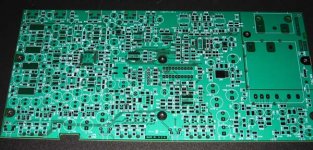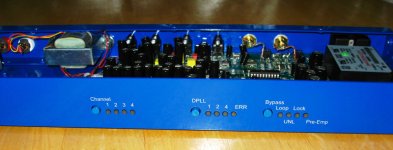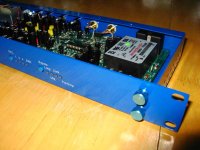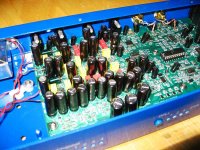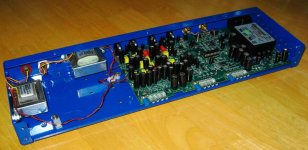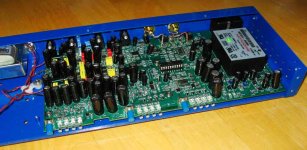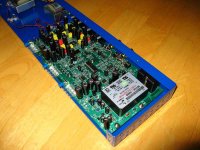fmak said:
Actually regardless of the SW4 setting, the lock light flickers on sometimes and produces a series of pops.
I've got something similar. I use a PC for a source. When set to 96KHz, the lock light goes out, though it sometimes flickers. However when I actually play a file at 96KHz, it locks properly and plays as it should. Then the track finishes and lock disappears a gain ... weird.
Not a big problem, and needs futher investigation, but I thought I'd mention it in case it helps shed some light on things.
Standard oscillator, FPGA... it I2S locks on whatever I've tried.
For SPDIF I tried 44k1, 48k, 96kHz it worked flawlessly.
However, when I was playing with FPGA/I2S (trying weird stuff) I managed to get DAC "stuck" on non-zero value (non 1.6V). So be caucus when playing with FPGA/I2S not to blow speakers (if having DC-coupled system w/o protection)!
Cheers,
Matej
For SPDIF I tried 44k1, 48k, 96kHz it worked flawlessly.
However, when I was playing with FPGA/I2S (trying weird stuff) I managed to get DAC "stuck" on non-zero value (non 1.6V). So be caucus when playing with FPGA/I2S not to blow speakers (if having DC-coupled system w/o protection)!
Cheers,
Matej
D1 as I/V ?
since i was lucky and will receive the DAC hopefully soon. I would like to ask if somebody has tried the DAC with an D1 stage as I/V ?
Or if they would be any theoratical concerns using the D1 with the DAC.
And a second questions or confirmation. I also have a Denon 1920 which should be used as source.
For PCM i would use PIN :
PLRCK (51) - Left/Right clock
PBCK (50) - Bit Clock
PDATA1 (46) - PCM DATA
For DSD i would connect it through the vias at DBK,DSD1,DSD2
outlined by Russ.
Has anybody modified the power supply of the Denon already ? I'm still searching for a schematic of this player.
thx
since i was lucky and will receive the DAC hopefully soon. I would like to ask if somebody has tried the DAC with an D1 stage as I/V ?
Or if they would be any theoratical concerns using the D1 with the DAC.
And a second questions or confirmation. I also have a Denon 1920 which should be used as source.
For PCM i would use PIN :
PLRCK (51) - Left/Right clock
PBCK (50) - Bit Clock
PDATA1 (46) - PCM DATA
For DSD i would connect it through the vias at DBK,DSD1,DSD2
outlined by Russ.
Has anybody modified the power supply of the Denon already ? I'm still searching for a schematic of this player.
thx
Sabre Sonics (lawng post)
The story so far: Have been listening to and modding the Sabre/Buffalo, and am now concluding that the Sabre passes what I call the chameleon test: every time I think it has a character, I find it was something else in the chain or something with the implementation of it. It is the first delta-sigma (or sigma-delta) DAC I have warmed up to.
The reference systems include: Yamaha C5 Concert Grand Piano. Denon PMAS1, Lavardin IS Ref, and custom Triode amps. Fried M7 and Newform ribbon speakers, Stax headphones. Heavily modded Sonic Frontiers T3/P3 and custom PCM63 DACs as digital sources. Decent cables, clean AC, carbon fibre shelving.
The Sabre chip is very context sensitive, ie power supplies need to be clean and quiet, and although it has excellent jitter rejection, one can still hear changes upstream, and the jitter rejection improves with better power supplies. Less interaction between sections. Reason #44100 why spdif is still evil. Each improvement supports the others, but one alone might not be enough, ie one might not hear diferent clocks if the analog supply is derived from the digital one, but it is clearly audible in tandem.
In stock form, the Buffalo has potential: good prat, solid L/R imaging, but horrible rendition of space, and an irritating digital character: initially sounds clean, but quickly becomes fatigueing(sp?). Tipped up tonal balance, threadbare rather than neutral, not warm, liquid, rich. A decent implementation, but suffering from the classic pitfalls of digital: no involvement, needs garlic. Slightly smoother, better with the soft filter setting. Frankly, it would be a waste of time to be concerned with the pros and cons of various I/V schemes for current output mode when the basic foundation of clean power and clock is not in place. Voltage out through good iron is quite sufficient. Good iron being key here. I will repeat the gentle suggestion for a B2 (the riboflavin?) with maybe $30 extra in regs/caps.
For those who are impressed with the sonics of the demo board or the Buffalo, you ain't heard nuttin yet. For those doing their own layouts, do indeed pay close attention to clean power. Gordon at Wavelength is spot on with 8 something discrete regulators. For the rest of us, integrated solutions are still quite good, and easily within reach.
Buffalo specifics: The analog power being derived from the digital supply, while not jar-jar bad, needs to go. The 1.2V core supply reg hanging off the 3.3V digital supply reg is a no-no. The clock needs it's own reg, not just hanging off the digital supply. The spdif comparitor hanging off the digital supply needs to be ****canned. Use i2s input mode, with something off board to process spdif.
Two LT1963A 3.3 EST for 3.3V digital and clock. Different pinout from the 1117 series regs. 470uF to 1500uF bypass caps. Big bypass caps at the reg, small 1uF at the chip. The Crystek clock module is sufficient, but needs a separate reg. Separate 3.3 or 5 volt pre-reg for the 1.2 volt core reg. An LT1027 ref through a 5k/10k r/2r divider with 470uF cap at inputs of the opamps to get 3.33 volts for analog. The National LM4562 opamp buffers are decent, just need clean/quiet source, like the LT1027, and larger bypass at the outputs to keep impedance from spiking. 1500uF low ESR bypass caps work well. The LT1027 has a noise reduction pin, use it. A 27uF low esr low leakage cap works there. A single supply of 7.5V is sufficient feeding this arangement, an LT1431 with an LT1086 or LT317 *inside* the loop, with a 2r/r divider to give 7.5 V. Big bypass cap, of course.
Voltage out: Lundahl LL1676 amorphous core 2+2:1+1 with the two "2" windings in parallel across the diff analog outs of Sabre. A 4700pF cap also across the diff outs for more out of band filtering. The "1" windings can be series for balanced/single out, or parallel for single out. This gives an output impedance of a bit under 400 ohms balanced, and a bit under 100 ohms single ended, while letting the chip and tranny rip. The Sabre has vanishingly low residual offset, so the trannies can be DC coupled. Obviously, one gets quite good common mode rejection going the transformer route. Also, no extra bipolar power supplies needed, car audio...? The Sabre has apparently got quite good thermal matching through good (internal) layout, and the geometry of the devices likely has time constants short enough for sufficiently fast settling. If feeding a high impedance, low sensitivity amp, like one with glowing triodes, flip the trannies and go 1:2 for lots of voltage out with a still quite manageble 1600 ohm output Z.
More specifics: The wierd muckup of the bass with the Wolfson spdif appears to be a poor "match" of time constants between the Wolf dpll and the Sabre hyperstream jitter reduction. I suspect that the Wolf is curve fitting along the envelope to give nice wide eye patterns and low measured jitter at high frequencies at the expense of wobble at low frequencies. Reason # 44101 why spdif is still evil. The the caucasian filter: lacklustre pacing, can't dance. I hear this quite clearly comparing live to recorded Piano. It would be easy to miss if the reference was not live: a lot of recordings have this characteristic. I remember a chuckle from an audio show back in the nineties: high end A/V display played a video clip from the Eagles. First note, about half of the front row, myself included, stood up and left. At a hotel in California, we did not want to hear Hotel California. Anyhow, I alleviated the Wolf by removing the low freq rolloff at the spdif input with a differentiator feeding a pair of window comparitors feeding a S/R ff DC coupled to the spdif in. Not a purist approach for 75ohm matching, not a commercially viable solution, but it works for DIY. No schematic, as I did it on the fly. I am building a CS8416 spdif to i2s board, we shall see. With an ultrasonic jitter corner, the phase noise of the source will be dominant, and maybe we can let the Sabre's excellent jitter rejection shine.
Recap in honor of Mercury Retrograde: LT1963A for 3.3 volt regs, LT1027 5V ref padded to 3.3 for analog. Separate clock reg. Separate pre-reg for the 1.2V core reg. Phat bypass caps. Looped LT1431/LT1086 reg feeding the card. Lundahl LL1676 amorphous core parallel primaries, with 4700pF cap across them. Still evolving, looks like a Frankenstein with all the added parts...but day and night sonics so far. Layout when it settles sufficiently.
The story so far: Have been listening to and modding the Sabre/Buffalo, and am now concluding that the Sabre passes what I call the chameleon test: every time I think it has a character, I find it was something else in the chain or something with the implementation of it. It is the first delta-sigma (or sigma-delta) DAC I have warmed up to.
The reference systems include: Yamaha C5 Concert Grand Piano. Denon PMAS1, Lavardin IS Ref, and custom Triode amps. Fried M7 and Newform ribbon speakers, Stax headphones. Heavily modded Sonic Frontiers T3/P3 and custom PCM63 DACs as digital sources. Decent cables, clean AC, carbon fibre shelving.
The Sabre chip is very context sensitive, ie power supplies need to be clean and quiet, and although it has excellent jitter rejection, one can still hear changes upstream, and the jitter rejection improves with better power supplies. Less interaction between sections. Reason #44100 why spdif is still evil. Each improvement supports the others, but one alone might not be enough, ie one might not hear diferent clocks if the analog supply is derived from the digital one, but it is clearly audible in tandem.
In stock form, the Buffalo has potential: good prat, solid L/R imaging, but horrible rendition of space, and an irritating digital character: initially sounds clean, but quickly becomes fatigueing(sp?). Tipped up tonal balance, threadbare rather than neutral, not warm, liquid, rich. A decent implementation, but suffering from the classic pitfalls of digital: no involvement, needs garlic. Slightly smoother, better with the soft filter setting. Frankly, it would be a waste of time to be concerned with the pros and cons of various I/V schemes for current output mode when the basic foundation of clean power and clock is not in place. Voltage out through good iron is quite sufficient. Good iron being key here. I will repeat the gentle suggestion for a B2 (the riboflavin?) with maybe $30 extra in regs/caps.
For those who are impressed with the sonics of the demo board or the Buffalo, you ain't heard nuttin yet. For those doing their own layouts, do indeed pay close attention to clean power. Gordon at Wavelength is spot on with 8 something discrete regulators. For the rest of us, integrated solutions are still quite good, and easily within reach.
Buffalo specifics: The analog power being derived from the digital supply, while not jar-jar bad, needs to go. The 1.2V core supply reg hanging off the 3.3V digital supply reg is a no-no. The clock needs it's own reg, not just hanging off the digital supply. The spdif comparitor hanging off the digital supply needs to be ****canned. Use i2s input mode, with something off board to process spdif.
Two LT1963A 3.3 EST for 3.3V digital and clock. Different pinout from the 1117 series regs. 470uF to 1500uF bypass caps. Big bypass caps at the reg, small 1uF at the chip. The Crystek clock module is sufficient, but needs a separate reg. Separate 3.3 or 5 volt pre-reg for the 1.2 volt core reg. An LT1027 ref through a 5k/10k r/2r divider with 470uF cap at inputs of the opamps to get 3.33 volts for analog. The National LM4562 opamp buffers are decent, just need clean/quiet source, like the LT1027, and larger bypass at the outputs to keep impedance from spiking. 1500uF low ESR bypass caps work well. The LT1027 has a noise reduction pin, use it. A 27uF low esr low leakage cap works there. A single supply of 7.5V is sufficient feeding this arangement, an LT1431 with an LT1086 or LT317 *inside* the loop, with a 2r/r divider to give 7.5 V. Big bypass cap, of course.
Voltage out: Lundahl LL1676 amorphous core 2+2:1+1 with the two "2" windings in parallel across the diff analog outs of Sabre. A 4700pF cap also across the diff outs for more out of band filtering. The "1" windings can be series for balanced/single out, or parallel for single out. This gives an output impedance of a bit under 400 ohms balanced, and a bit under 100 ohms single ended, while letting the chip and tranny rip. The Sabre has vanishingly low residual offset, so the trannies can be DC coupled. Obviously, one gets quite good common mode rejection going the transformer route. Also, no extra bipolar power supplies needed, car audio...? The Sabre has apparently got quite good thermal matching through good (internal) layout, and the geometry of the devices likely has time constants short enough for sufficiently fast settling. If feeding a high impedance, low sensitivity amp, like one with glowing triodes, flip the trannies and go 1:2 for lots of voltage out with a still quite manageble 1600 ohm output Z.
More specifics: The wierd muckup of the bass with the Wolfson spdif appears to be a poor "match" of time constants between the Wolf dpll and the Sabre hyperstream jitter reduction. I suspect that the Wolf is curve fitting along the envelope to give nice wide eye patterns and low measured jitter at high frequencies at the expense of wobble at low frequencies. Reason # 44101 why spdif is still evil. The the caucasian filter: lacklustre pacing, can't dance. I hear this quite clearly comparing live to recorded Piano. It would be easy to miss if the reference was not live: a lot of recordings have this characteristic. I remember a chuckle from an audio show back in the nineties: high end A/V display played a video clip from the Eagles. First note, about half of the front row, myself included, stood up and left. At a hotel in California, we did not want to hear Hotel California. Anyhow, I alleviated the Wolf by removing the low freq rolloff at the spdif input with a differentiator feeding a pair of window comparitors feeding a S/R ff DC coupled to the spdif in. Not a purist approach for 75ohm matching, not a commercially viable solution, but it works for DIY. No schematic, as I did it on the fly. I am building a CS8416 spdif to i2s board, we shall see. With an ultrasonic jitter corner, the phase noise of the source will be dominant, and maybe we can let the Sabre's excellent jitter rejection shine.
Recap in honor of Mercury Retrograde: LT1963A for 3.3 volt regs, LT1027 5V ref padded to 3.3 for analog. Separate clock reg. Separate pre-reg for the 1.2V core reg. Phat bypass caps. Looped LT1431/LT1086 reg feeding the card. Lundahl LL1676 amorphous core parallel primaries, with 4700pF cap across them. Still evolving, looks like a Frankenstein with all the added parts...but day and night sonics so far. Layout when it settles sufficiently.
Re: Sabre Sonics (lawng post)
Thanks for the comments.
I am wondering how much improvment you see by giving the Sabre it's own quiet 3V3 digital supply, versus sharing the 3V3 digital with a few other digital logic ICs.
I thought the 3V3 digital was just for logic level interface of digital signals.
Other than that, I have somewhat implemented a lot of the other improvments you mention, but not exactly as you have done. Hundreds of caps on my PCB.
wildmonkeysects said:The story so far: Have been listening to and modding the Sabre/Buffalo,
...
Two LT1963A 3.3 EST for 3.3V digital and clock. Different pinout from the 1117 series regs. 470uF to 1500uF bypass caps. Big bypass caps at the reg, small 1uF at the chip.
...
Thanks for the comments.
I am wondering how much improvment you see by giving the Sabre it's own quiet 3V3 digital supply, versus sharing the 3V3 digital with a few other digital logic ICs.
I thought the 3V3 digital was just for logic level interface of digital signals.
Other than that, I have somewhat implemented a lot of the other improvments you mention, but not exactly as you have done. Hundreds of caps on my PCB.
Re: Sabre Sonics (lawng post)
Great to learn from your experiences.
Cheers,
Tom
wildmonkeysects said:The story so far: Have been listening to and modding the Sabre/Buffalo, and............
Great to learn from your experiences.

Cheers,
Tom
Corrections I should of made a while ago
A few weeks back I posted a statement I wish to correct. I said the "Samsung was the first to have Sabre into production" While this is true for the ES9006 psrt (the 9008 little brother) I would like to point out that Twisted Pear's Buffalo, is really the first to have the 9008 in production. Just wanted to clear the air.
Thanks
Dustin
BTW, I love reading all the stuff about this chip. I hope to hear of things that could have been done better since I want to keep learning. I like the moments when I go "Damn, why didn't I think of that"
A few weeks back I posted a statement I wish to correct. I said the "Samsung was the first to have Sabre into production" While this is true for the ES9006 psrt (the 9008 little brother) I would like to point out that Twisted Pear's Buffalo, is really the first to have the 9008 in production. Just wanted to clear the air.
Thanks
Dustin
BTW, I love reading all the stuff about this chip. I hope to hear of things that could have been done better since I want to keep learning. I like the moments when I go "Damn, why didn't I think of that"
Re: Corrections I should of made a while ago
Hi Dustin et all: Indeed, credit is due for Twisted Pear's Buffalo being first out the door; the fact that it exists calls for attaboys and kudos. I appreciate them every time I fire it up. The good news / bad news about being a "pioneer species" is that there will be feedback from other critters showing up later on the landscape.
That the Sabre chip is more than holding it's own in comparison with ridiculously more expensive hardware is impressive.
Somebody, maybe TP, (not me! I think retail is for masochists, but am glad somebody else is doing it) is going to come up with a kickass, tricked out implementation of the Sabre for waay cheap, maybe usb and spdif versions.
rossl: I did a simple test (borrowed time at a telecom lab, HP spec analyzers) of jitter induction thru shared supply lines: an xtal osc with it's own reg through a simple 74xx04 with it's own separate reg. The spectrum of the phase noise "skirt" looked virtually the same, except when a digital signal was sent through another section of the 04: the spectrum at the osc remained clean, but there were spurs, correlated of course, easily 20 dB above the phase noise floor at the 04 output. Subjectively, I find correlated stuff to be more annoying, whereas random stuff tends to be either pleasant or boring.
Share and enjoy,
WMS
Hi Dustin et all: Indeed, credit is due for Twisted Pear's Buffalo being first out the door; the fact that it exists calls for attaboys and kudos. I appreciate them every time I fire it up. The good news / bad news about being a "pioneer species" is that there will be feedback from other critters showing up later on the landscape.
That the Sabre chip is more than holding it's own in comparison with ridiculously more expensive hardware is impressive.
Somebody, maybe TP, (not me! I think retail is for masochists, but am glad somebody else is doing it) is going to come up with a kickass, tricked out implementation of the Sabre for waay cheap, maybe usb and spdif versions.
rossl: I did a simple test (borrowed time at a telecom lab, HP spec analyzers) of jitter induction thru shared supply lines: an xtal osc with it's own reg through a simple 74xx04 with it's own separate reg. The spectrum of the phase noise "skirt" looked virtually the same, except when a digital signal was sent through another section of the 04: the spectrum at the osc remained clean, but there were spurs, correlated of course, easily 20 dB above the phase noise floor at the 04 output. Subjectively, I find correlated stuff to be more annoying, whereas random stuff tends to be either pleasant or boring.
Share and enjoy,
WMS
The good news / bad news about being a "pioneer species" is that there will be feedback from other critters showing up later on the landscape.
Definitely good news as far as I am concerned.
Sabre8 prototype DAC
My Sabre8 prototype is turned on and making music.
The circuit board. It is a 4-layer boards. There was a few problems with the first one so this one is revision B. I was able to tweak the first one to get excellent sound and I made those changes in this version.
Layer2 is a solid ground plane. All digital traces are impedance controlled. The analog section has an AVCC plane and planes for the +/- analog supplies. Digital side has plane for 3V3.
My Sabre8 prototype is turned on and making music.
The circuit board. It is a 4-layer boards. There was a few problems with the first one so this one is revision B. I was able to tweak the first one to get excellent sound and I made those changes in this version.
Layer2 is a solid ground plane. All digital traces are impedance controlled. The analog section has an AVCC plane and planes for the +/- analog supplies. Digital side has plane for 3V3.
Attachments
The DAC features a 4-input switch and a processor loop. The processor loop allows the switched signal to be sent out to a DSP equalizer and then returned to the Sabre8.
After the input switch the switched signal is sent out a TOSLINK port and also goes to a mux. A front panel switch controls the mux and selects either the switch output or the processor loop input.
After the input switch the switched signal is sent out a TOSLINK port and also goes to a mux. A front panel switch controls the mux and selects either the switch output or the processor loop input.
Attachments
- Home
- Source & Line
- Digital Line Level
- ESS Sabre Reference DAC (8-channel)
